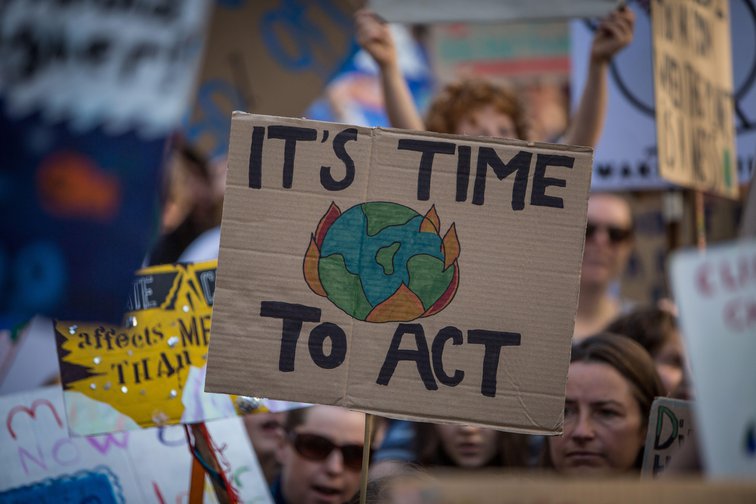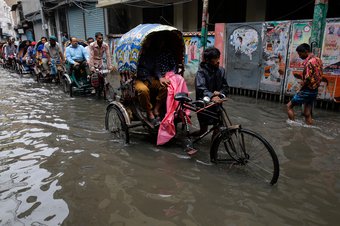Tackling the climate crisis must not come at the expense of eradicating global hunger
Relying on planting trees to meet net zero targets is not only practically impossible – it risks pushing millions deeper into poverty
 |
5 August 2021
With fewer than 90 days to go until the UK hosts the COP26 climate summit in Glasgow, we can expect to hear a lot more about the much-heralded goal of reaching ‘net zero’ carbon emissions. While this goal is important, there is a risk that too many of these plans are implausible and may become a dangerous smokescreen that hides a lack of near-term action by governments and corporations.
Boris Johnson often presents the UK as the godfather of net zero, having been one of the first countries to pass a net zero target into law. But if the prime minister wants to deliver a deal that prevents climate catastrophe, he cannot afford for this to become a distraction from radical action to reduce emissions now.
To be clear, net zero targets are vital to tackling climate change and have unleashed a wave of much-needed energy and optimism. Barely a week goes by without a new country or company announcing a target to achieve net zero carbon emissions. More than 120 countries, including big emitters such asChina, the US and the European Union, have pledged to achieve net zero by the middle of the century. A wave of companies and investors including British Airways, Mars, Unilever, Citigroup, BlackRock, Shell and BP have followed suit.
But what do these targets actually mean, and can they be trusted? Every net zero target is like a seesaw: it promises to balance the carbon still being released with measures to remove carbon from the air, at some point in the future. Currently the vast majority of countries and corporations are nowhere close to achieving that balance, but they assure us the weight is shifting.
The carbon removal part is the difficult bit. Setting aside all the virtually unproven new technologies that promise to suck carbon from the air, the only guaranteed known way to remove carbon is to use land to grow billions of trees and to store carbon in plants and soil. It is in this area that far too many governments and companies are pinning their hopes.
The total land required for planned carbon removal may be equivalent to all the farmland on the planet
We at Oxfam have estimated that just four oil and gas producers (Shell, BP, Total and ENI) would require an area of land twice the size of the UK for tree planting to meet their net zero pledges. If the entire energy sector adopted similar targets, it could end up requiring land the size of the Amazon rainforest. We estimate that the total amount of land required for planned carbon removal could potentially be five times the size of India, equivalent to all the farmland on the planet.
As well as being mathematically impossible, some net zero targets risk becoming a dangerous diversion from the immediate need to reduce emissions. The four fossil fuel companies mentioned above plan to continue producing oil and gas – effectively writing ‘IOUs’ while going on a carbon-spending spree. Many of their peers do not even have net zero targets.
This doublethink is not only happening in the private sector. The UK government has set world-leading climate targets in recent years and has marshalled the diplomatic cavalry to jockey others. Yet media reports suggest it is poised to approve plans for a new North Sea oil and gas project that could produce 255 million barrels of oil until the year 2050 (the company has applied for licences to extract 170 million so far). That project alone would release an estimated 132 million tonnes of CO2 emissions, and removing them through planting trees would require a forest larger than England.
An explosion in demand for land to offset carbon emissions would inevitably mean less land to grow food. We are already living on a planet where the number of hungry people is increasing: every minute around the world 11 people are likely to die from acute hunger linked to conflict, COVID-19 and the climate crisis. The last thing we need to do is to turn vast tracts of cropland into carbon sinks.
There is also the risk of people being pushed off their land – especially in lower-income countries. We have seen examples of this already: In India, traditional lands have been fenced off as part of a government-sponsored forestation drive, and communities that have rights to use this land have been forcibly evicted and left homeless. These conflicts are affecting nearly half a million tribal and forest-dwelling people.
As we approach COP26, governments and corporations will compete to show off their pledges and claim they are doing their bit. If we are to save our planet and prevent millions of people from being pushed deeper into hunger and poverty, it is critical that they are not allowed to get away with vague net zero targets, which when viewed in the context of others are unachievable.
Our political and business leaders must be asked relentlessly what their plans are to cut their own carbon emissions in the next year, by 2025 and by 2030. Transparent targets should distinguish between reducing and removing carbon instead of blurring the boundaries.
Land and nature are important parts of the solution, but we must strive for zero hunger as well as zero emissions by strengthening the rights and bolstering the livelihoods of at-risk communities. Making millions more people hungry is no solution to a climate crisis. In short, we must tighten the ‘net’ in net zero.




No comments:
Post a Comment
Note: only a member of this blog may post a comment.